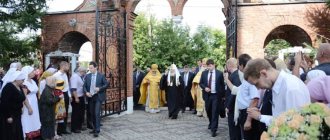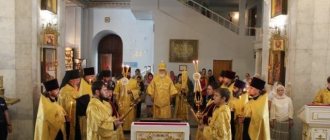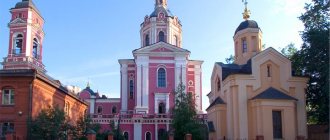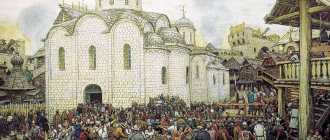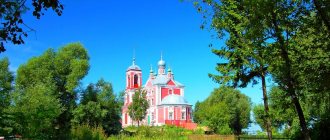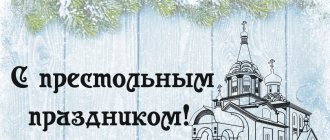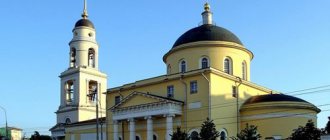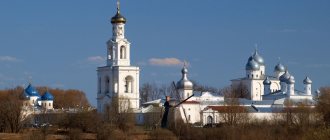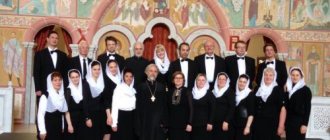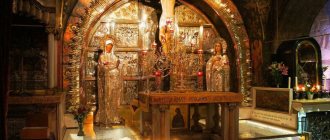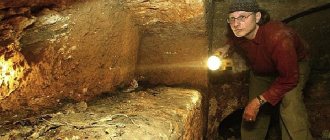History of construction
Until 1816, the venue for the fair was the Makaryevsky Monastery, located in the village of Makaryevo, 88 km away. from Nizhny Novgorod. In 1816, there was a fire in Makaryev, the fair's structures were badly damaged, and a decision was made to move the fair to Nizhny Novgorod. The territory chosen for the new fair was very vast and picturesque - on the spit, at the confluence of the Volga and Oka rivers. In 1817, the state allocated significant funds for the construction of a fair complex, the dominant feature of which was to be a majestic Orthodox cathedral.
© Alexander Orlov
An experienced mechanical engineer and builder, Lieutenant General Augustin Betancourt (1758–1824), a Spaniard by birth who served in the Russian Empire, was entrusted with leading the construction of the new fair. According to Betancourt, the new fair in Nizhny Novgorod was to become one of the best and most progressive trading platforms at the European level. For the construction of the main Orthodox cathedral, Betancourt invited the famous architect Auguste Montferrand (1786–1858), an architect of French origin, who at the same time was working in St. Petersburg on the design of St. Isaac's Cathedral.
© Irina Nechaeva
The founding date of the Spassky Old Fair Cathedral is considered to be August 1, 1818, and on July 5, 1822, the main altar of the Spassky Old Fair Cathedral was consecrated. Among the main shrines of the Spassky Old Fair Cathedral are icons with particles of the relics of Saint Prince Alexander Nevsky, Venerable Seraphim of Sarov, Princes Peter and Fevronia of Murom, as well as the icon of the Most Holy Theotokos “Joy of All Who Sorrow,” the icon of the Savior Not Made by Hands.
Temple in honor of the Transfiguration of the Lord
- home
- Parishes
- Temple in honor of the Transfiguration of the Lord
→
→
Throne
The main one is in honor of the Transfiguration of the Lord (August 19).
The right side chapel is in honor of St. Nicholas, Archbishop of Myra in Lycia, wonderworker (May 22/December 19).
The side altar is in honor of the Council of Nizhny Novgorod Saints.
The throne of the cave temple is in honor of the holy Venerable Joasaph, Prince of India (December 2).
Shrines
Under cover are the relics of the holy venerable schemamonk Joasaph of Pechersk, the Nizhny Novgorod wonderworker, which were found as a result of a landslide that destroyed the Pechersk Ascension Monastery at the end of the 16th century.
Story
On a small terrace, in a semi-mountain of the high right bank, on the approach to Nizhny Novgorod from the Volga Ponizovye, the buildings of the stone Church of the Transfiguration of the Savior rise, marking the original location of one of the oldest Nizhny Novgorod monasteries.
The Pechersk monastery was founded here in the 1330s by the monk Dionysius, a native of Kiev, a prominent church and political figure in Ancient Rus' of the 14th century, an interlocutor and associate of St. Alexy, Metropolitan of Moscow, and St. Sergius, the Wonderworker of Radonezh.
But on June 18, 1597, a misfortune occurred: underground springs deeply eroded the coastal soil, and the mountain slid in a huge mass into the Volga along with the buildings of the monastery and, as eyewitnesses of this event recalled, “... great mounds rose in the middle of the river: ships that stood under the monastery on the water , and those ships stood on the shore, on dry land, twenty fathoms from the water and more... under the mountain, the temple of St. Nicholas the Wonderworker and St. Euthymius the Wonderworker of Suzdal was completely moved..."
After this, the Pechersky Monastery had to be built anew, on a different spacious coastal site, a mile closer to the city, and the chopped church of St. Nicholas remained empty in its original place.
On May 4, 1640, a fire broke out in the Pechersky Monastery, destroying the log fence and the gate church in honor of St. Euthymius of Suzdal. At the same time, the monastery authorities decided to rebuild the holy gates with stone ones, and temporarily from the Old Caves “...that empty church was transferred to the monastery and placed on the holy gates and consecrated with a new antimension in the name of St. Euthymius of Suzdal.”
And so it was done. The place where the St. Nicholas Church stood in Starye Pechery was covered with earth and fenced off, and a memorial cross was placed in the center. After the main buildings of the Pechersky Monastery were rebuilt with brick by the middle of the 17th century, a new St. Nicholas Church was built in Old Pechery, and the lands near it were populated with two monastic settlements, in which by 1686 there were already 37 in one and 23 residential farmsteads of peasants in the other. , who became the main suppliers to the monastery, and then to the auctions of Nizhny Novgorod, of vegetables and, above all, cucumbers.
The log church of Starye Pechery stood until 1782, when the settlement burned down during a fire. The authorities of the Pechersk Monastery immediately turned to the Synod, firstly, for permission to build a stone church in the same place, and secondly, with a request to at least partially finance the work. Permission for stone construction was received, as well as 500 rubles, which were to be issued from the treasury in such cases.
The design of the temple was drawn up by the first Nizhny Novgorod provincial architect Yakov Ananyevich Ananyin in the forms traditional for that time: with a slender five-domed dome over a gabled eight-slope roof, with a spacious refectory and a hipped bell tower over the main western entrance.
In 1785, the brick temple was roughly built. At the same time, Bishop Damascene (1783–1794) consecrated the first warm chapel in the refectory in honor of the Apostle John the Theologian, and five years later - another chapel in honor of St. Nicholas. The iconostasis and the icons of the main altar took several more years to complete.
On June 13, 1798, Bishop Paul (1794–1798) consecrated the main altar of the temple. By that time, there were already six bells on the church bell tower, including the “Bolshoi” bell, weighing 54 pounds. Although the roofs of the temple and the refectory remained planked, all the chapters (including the chapters of the aisles) were upholstered in white iron, and the crosses were gilded.
Almost two centuries that have passed since then have brought minor changes to the image of the church, so it remains one of the few that largely retains its original appearance and is of great value as a monument of Nizhny Novgorod temple architecture of the late 18th century. In the 20th century the temple was active.
Mandatory catechetical conversations before the sacraments of Baptism and Marriage:
Fri, Sat 10:00–17:00
Sun 12:00–17:00
Catechists:
Fomichev Sergey Vladimirovich, tel. +7 920 060–69–40,
Fomicheva Natalya Aleksandrovna, tel. +7 908 238–56–25.
Sunday school for children:
Sat 15:30–18:00
Director - Natalya Nikolaevna Khudina.
Tel. +7 950 340–00–05.
Sunday School for Youth:
Sun 11:00–12:30
The course of study includes liturgics, catechism, New and Old Testaments, and Church history.
Personal conversations with a priest:
Sun 12:30
Contacts
Address: 603093, Nizhny Novgorod, Pechery settlement, 124.
Tel/fax:
8 accounting
8 temple
Travel to the “Mayak” or “Bear Valley” stops by buses No. 2, 40, 45, 52, 90; by minibuses 2, 17, 45, 57, 178, 198. Along the embankment of the Grebnoy Canal to the "Church" stop - by bus No. 5.
Photo gallery
Architecture
Spassky Old Fair Cathedral was built in the strict traditions of classicism, decorated on all four sides with strict porticos with columns. The main southern entrance is a four-column portico with two free-standing, richly decorated columns. The northern vestibule consists of a four-column portico, the eastern altar and western vestibule are decorated with pilasters. The five-domed cathedral, built of white stone, attracted the attention of contemporaries with its strict lines; today it is also impossible to pass by this majestic structure, the height of which is more than 40 meters.
© Elena Travnitskaya
The inside of the cathedral is richly decorated according to classical canons. Russian academician A.V. Stupin painted the walls of the cathedral. Later, these very first paintings were lost. The author of the first iconostasis of the cathedral was the Italian master F. Torricelli. The icons were made in the European style and were very different from the Orthodox ones. For example, some icons depicted naked human figures, which is unacceptable for Orthodox believers. It is not surprising that the first parishioners of the cathedral were surprised and embarrassed; many merchants began to come to the temple with their icons and pray. The error had to be corrected, and soon a new iconostasis was created for the cathedral by the architect V. P. Stasov (1769–1848), created strictly in accordance with Orthodox canons.
The Old Fair Cathedral, like other fair buildings, was built in a lowland. Soon after construction was completed, it became clear that during floods this area was subject to severe flooding. In the spring, the waters came close to the fairgrounds, often flooding them. One of the most severe floods was the flood of 1849, when, according to eyewitnesses, it was possible to sail to the Old Fair Cathedral by boat.
© Elena Travnitskaya
Many works were undertaken to strengthen the soil under the buildings and save them from the annual flooding, but to no avail. In 1873, the bulk soil under the buildings subsided and cracks appeared along the walls of the cathedral, the situation became very serious. However, no decision was made to demolish the building; Nizhny Novgorod architect R. Ya. Kilevein and his assistant P. S. Boytsov carried out large-scale reconstruction work to restore the foundation of the cathedral. In 1888, the structural integrity of the building was successfully restored and the Old Fair Cathedral was rededicated.
© Vladimir Gaidai
After the revolution of 1917 and the closure of the Nizhny Novgorod fair, the cathedral was planned to be demolished. But instead, a warehouse was placed within its walls, and apartments were located in the buildings adjacent to the cathedral. Iconostases, wall paintings, bells and much other valuable property of the cathedral were lost.
The situation began to change only in the early 1990s. In 1991, the Spassky Old Fair Cathedral was officially returned to the Nizhny Novgorod diocese. Immediately after this, repairs to the cathedral began, recreating its interior decoration, and reconstructing the walls and domes.
A fragment of the monument to the liquidators of the Chernoble accident, installed next to the cathedral, © Leonid Gilchenko
From April 1989 to September 2009, the Spassky Old Fair Cathedral served as the cathedral of the Nizhny Novgorod diocese, then these functions were assigned to the Cathedral in the name of the Holy Blessed Prince Alexander Nevsky (New Fair Cathedral), founded in 1864 and consecrated in 1881. By the way, the Spassky Cathedral received its second name, by which it is now known, Old Fair, only after the consecration of the Alexander Nevsky Cathedral, called New Fair, that is, in 1881.
Spassky Old Fair Cathedral on Google maps panorama
Interesting fact: the name of the cathedral - “Spassky”, on the one hand, is illegal, because none of the thrones of the cathedral were consecrated in honor of the Savior. The cathedral received this name because it was officially “assigned” to the Transfiguration Cathedral of the Nizhny Novgorod Kremlin, which, alas, has not survived today. The situation with names is further complicated by the fact that in Nizhny Novgorod there is another Spassky Cathedral - the Transfiguration Cathedral, which, to avoid confusion, is today called Sormovsky, according to its location.
On the territory adjacent to the cathedral today there is also a baptismal church, a chapel and a small chapel-burial vault - the burial place of Metropolitan Nikolai (Kutepov) of the Nizhny Novgorod and Arzamas diocese. In 2009, on the alley in front of the Old Fair Cathedral, a monument to the liquidators of the Chernobyl accident was erected. Next to the cathedral there is a belfry of 8 bells standing on the ground. Residential development is close to the cathedral, the area nearby is landscaped, there is a children's playground. The contrast between the solemn appearance of the cathedral and the almost “dormitory” area nearby is noteworthy.
Shrines
Typically, temples that have not been closed for a long time and have not been destroyed preserve many shrines. The Church of the Transfiguration is no exception in this sense.
- Cross from the 18th century.
- Shroud with the image of Jesus Christ, also from the 18th century.
- Icon of the Transfiguration of the Lord with a piece of stone from Mount Tabor.
- Ark with particles of St. relics: saints bgv. princes Peter and Fevronia, holy princes Boris and Gleb and George of Vladimir, St. John Chrysostom.
The Kazan Icon of the Mother of God arrived for the first time at the Transfiguration Cathedral
Also in the temple there are revered lists of icons of the Mother of God: “Kazan”, “Vsetsaritsa”, “Sign”, “Iverskaya”, “Tikhvin”. All of them are placed in icon cases.
